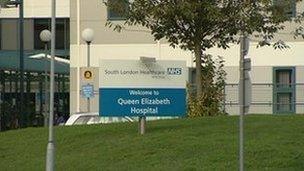Why South London Healthcare struggled
- Published

Money was spent on building a new hospital in Woolwich
When an NHS trust runs into financial difficulty it is normally because of one of three reasons - historic debt, not enough patients or costs it cannot control.
All three in effect apply to South London Healthcare and can explain why it has become the first trust to be put on a formal warning that it could be declared bust.
The trust was only created in 2009 after the merger of three hospitals - the Princess Royal in Orpington, Queen Mary's in Sidcup and the Queen Elizabeth in Woolwich.
By this point each was already posting end-of-year deficits. The combined annual debt was £21m.
Mounting pressures
On the patient side of things, it is not so much a case of too few but rather the wrong mix. The trust serves a population of over 1m and has high demand for emergency services. Indeed, the Queen Elizabeth in Woolwich is one of the busiest in the capital. And emergency patients are some of the most financially expensive to care for.
Hospitals rely on having a good flow of non-emegency patients coming through the doors as they are paid per patient treated for operations, such as knee and hip replacements, and outpatient appointments. This helps to keep their balance sheets healthy, but South London Healthcare does not have this.
The third major difficulty South London Healthcare has faced is that it is saddled with paying off two private finance schemes, which were used to build the hospitals in Orpington and Woolwich.
This year alone £61m in charges and interest will have to be paid, nearly 15% of the trust's turnover. And with the final payment not due until 2032, there is no light at the end of the tunnel.
Tax-payer bailouts
In recent years the trust has tried everything possible. It cut costs by £47m in 2010-11, but still posted a £40m deficit.
Work has been done to make its hospitals more productive by making operating theatres more efficient, increasing the number of day cases and trying to reduce overnight stays.
But the simple truth is that none of this is enough to solve its financial problem. It has only been kept afloat by bailouts from government and the local health economy in recent years.

The trust's deficit has spiralled beyond control
And, looking forward, even in the best-case scenario, the smallest the yearly deficit will shrink to is £15m over the next five years.
This prospect has led the health secretary to warn that the financial plan is not credible.
In all likelihood the trust will be placed into administration.
If that does happen and the administrator concludes the trust should be dissolved, the next big question will be what happens to the services. It is quite possible that some will be kept open as other NHS trusts or even a private provider may want to take them on, much as in the private sector when the profitable arms of a business are picked up by other firms.
Perhaps surprisingly, the news has not been greeted with complete dismay at the trust. A spokesman said it had been clear for some time that "something needs to be done". However, there is concern about the impact it will have on staff. Even the health secretary lamented it would be "unsettling".
While its financial position has meant it has struggled to meet the 18-week waiting time target, the trust has still made improvements in care when it comes to death rates and infections.
But while all eyes are on this trust at the moment, attention will soon turn to other financially challenged ones.
The Department of Health has identified 21 trusts deemed not to be clinically or financially viable in the current form - that is about a tenth of the hospital network. But what is interesting is the geographical spread of these trusts - half in or around London.
The capital simply has too many hospitals.
Work is already under way to tackle the problems, but a review by consultants McKinsey and Company for the Department of Health has warned that for several tusts the problems are particularly serious.
At this stage it is too early to say whether there will be other trusts which will be put on the unsustainable providers regime as South London Healthcare has.
But what remains clear is that there is a gathering momentum for the big decisions not to be ducked. The move by the health secretary last night, while controversial to those outside the health service, has been welcomed by many inside it.
- Published26 June 2012
- Published19 August 2011